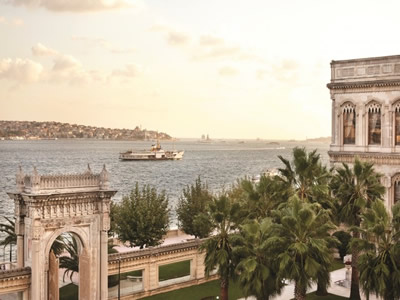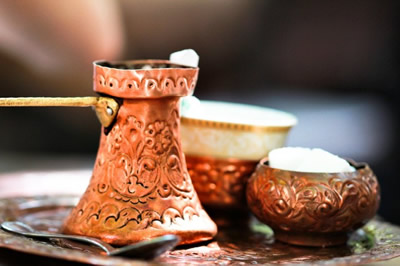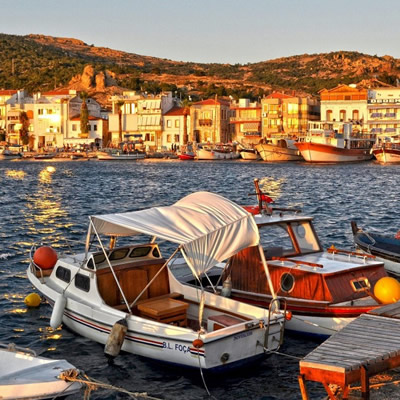 |
|
|
|
|
|
|
|
|
|
|
|
|
|
|
|
|
|
|
|
|
|
|
|
|
|
|
 |
 |
|
|
|
|
|
|
|
|
|
|
|
|

|
Istanbul + Izmir
Meet at the Crossroads of Two Continents
The magisterial 19th-century imperial palace we’re exploring in Istanbul was once home to ruling sultans of the Ottoman Dynasty. It is everything we’d hoped: room after room filled with brilliant chandeliers, sumptuous rugs, quarry-loads of marble and elegant open spaces where the sultans once held court over the empire. The 16-foot windows frame the blue-sky morning; the endless silk curtains sway in the breeze; and just below, the mighty Bosphorus Strait courses through the heart of Istanbul—the gateway between Europe and Asia. Standing here, you can’t help but feel the weight of important history. Today, part of the palace is incorporated into the luxurious 313-room Ciragan Palace Kempinski Istanbul. The group moves quickly, since we’re anxious to see the hammam, a Turkish bathhouse designed with filigreed white marble. But we’re stopped suddenly by a delicate music emanating from a half-closed door. Peeking into another giant sunny room, we spy a quiet meeting of eight while a harpist plucks away gently to coax out fresh inspiration. The Palace’s 16 meeting rooms hold events from small cabals to 900-seat dinners and 1,500-pax parties for Oprah. This hotel we’re told is one of the city’s proudest achievements in historic preservation and urban redesign, which is saying something in Istanbul. “Built in 1874 by the painter-emperor Abdul Aziz, we are the only former residence of sultans open as a hotel,” explains GM Ralph Radtke. Inside the old palace, there are 11 ultra-premium suites with as many as 16 rooms each, while the remaining rooms and 22 suites are in the adjoining three-wing deluxe hotel. Even the walk between buildings is a treat, complete with ambient music composed by the sultans. We are met by Kempinski’s “Ladies in Red” hostesses who proffer cool towels and drinks followed by an escort to our rooms for ensuite check-in. “This is a Kempinski-wide practice but the custom began here,” says Radtke. “We give a truly personal welcome.” All of the rooms have rich local textiles, marble bathrooms, handpainted tiles and large sliding doors with private balconies, 80% of which have Bosphorus views. My Lady in Red asks how I’d like to do begin my stay at the hotel, or was I too busy perhaps to partake in a welcome Turkish coffee and Turkish bath?
Nope. Afternoon coffee takes place in The Gazebo, one of four onsite restaurants. The breezy indoor/outdoor space is humming with a cosmopolitan crowd all enjoying the million-dollar views. Meeting over Turkish coffee—a luscious concoction of boiled finely ground beans and a jelly confection called Turkish delight—is an institution. As the rest of our group streams in, we’re quickly bonding with Radtke and each other while enjoying the rich drama of the setting. The hammam is another Turkish delight, sans calories. Traditional bathing spaces still dot the city, but Kempinski has an opulent Sanitas Spa and a staff well versed in the “old ways,” says Radtke. After a quick rinse and soak, we head into heated marble rooms for the scrub down from an attendant using super course mitts to clear away dead skin. Afterward, a gentle spray of soap bubbles makes us feel like we’re floating. Finally the head massage—don’t skip it—with balsam shampoo. “You feel just like a baby, don’t you?” asks Radtke. “And then you want to go to sleep.” Our welcome dinner takes place at Tugra where Ratdke says the chefs have painstakingly researched the sultans’ secret recipes, cooking methods and spices developed throughout the Ottoman empire that spanned Northern Africa, Asia and Europe. Lamb kulbasti in walnuts and eggplant with pomegranate sauce put all previous grilled lambs to shame, capped by a wonderful nut butter halva dessert. The dining room features a mural harking back to the sultanate, a gold-leaf wine cellar/10-pax tasting room, and those incredible palace windows. Turkish Tours You have to try the raki, Turkey’s national drink made of fermented raisins and anise, and the best place to do it is at the town’s hippest restaurant, Reina. Actually it’s six restaurants gathered beneath the Bosphorus Bridge where everyone from Bon Jovi to Salma Hayek has brought groups here for the nightly light show. The variety of indoor/outdoor venues provides a unique ambiance. To create such an event, contact Mustafa Yalcin and his staff at Universal Travel Services DMC. Yalcin also recommends a cruise on the Bosphorus as the best intro into the region’s history. “A Bosphorus cruise lets you take in the city’s domes and minarets while placing you right between Europe and Asia on the busy route between the Black Sea and the Mediterranean,” says Yalcin as we board a 20-person boat at Kempinski’s dock. As we float down the river, Yalcin makes the colorful history come alive, explaining why Constantine moved the Roman Empire here in 330, and why the Ottomans fought for it a thousand years later. Heading inside the 5th-century walls of Constantinople, we begin at the 6th-century Hagia Sofia, the seat of the Byzantine Empire and the world’s largest cathedral for almost 1,000 years. The beautiful domed mosaic roof is propped up with 107 marble pillars, many from ancient pagan temples. When the Ottomans arrived in 1453, they converted it into a mosque, and today, it’s one of the world’s great history museums. Just across the ancient site of the Hippodrome sporting complex, the 17th-century Blue Mosque and its grand domes and six minarets are visible from all of Istanbul. Over 20,000 brilliant blue ceramic tiles inspire awe of both the artistry and serene setting. That’s followed by Topkapi Palace, the world’s oldest and largest palace, spread over 172 acres. Yalcin guides us through the succeeding rings of privilege all the way to the harem’s inner chambers. Finally, the intoxicating Grand Bazaar is the mother of all malls, containing 3,000 shops on 61 covered streets. Everyday up to 400,000 visitors come seeking rugs, shoes, scarves, lamps and jewelry. The experience is a wholly consuming, full frontal immersion in Turkish culture. Nearby, the 6th-century Basilica Cistern is a Roman engineered, cathedral-size water tank. The 100,000-sf space hosts 500-pax events in a beautiful underworld supported by 336 columns from the old Greco-Roman temples. Afterward, we meet with the gracious Elif Balci, chairman of Istanbul CVB, who wants us to know that visits to Istanbul revolve around more than the Kempinski Place, Blue Mosque and Bazaar. Izmir & Ephesus
A one-hour flight from Istanbul and Turkey’s third largest city, Izmir is located on the shores of the Aegean Sea, loaded with Greek, Roman and Byzantine history. For example, Hande Arslanalp of Italtours DMC escorts us to the ancient ruins of the Kadifekale fortress high above the city. The still-intact walls rise around ancient Roman cisterns under present excavation, where Arslanalp shows us a trickle of water that has been piped uphill for over 2,000 years. Most groups make the one-hour daytrip to Ephesus to see the largest collection of Roman ruins in the eastern Mediterranean. Walking the dusty streets of Homer to the great Library of Celsus is an unforgettable experience for culture buffs. One of the seven wonders of the ancient world, the Temple of Artemis has only one of its original 129 columns still intact. We checked into the 402-room Swisshotel Grand Efes Izmir, situated on landscaped gardens near the palm-lined waterfront Kordon Promenade. The area is great for shopping, cocktails and, yes, more Turkish coffee. Among four onsite restaurants, we inhaled the fresh mezze at Café Swiss with views of the gorgeous courtyard. The 316-room Kaya Izmir Thermal & Convention rises in a piney grove on the site of the ancient Agamemnon Springs, just 10 minutes from town. According to legend, an oracle sent Agamemnon’s troops to the warm springs here to heal their wounds. -- Alexis Quinlan Winter, 2012-13Reprinted with permission of Prevue/prevueonline.net (edited version). To read the original article visit http://www.prevueonline.net/blog/themes/culture/istanbul-izmir-turkey-meet-at-the-crossroads-of-two-continents. | ||||||||


